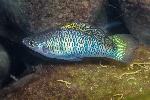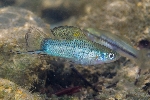
Dissolution of Sexual Signal Complexes in a Hybrid Zone between the Swordtails Xiphophorus birchmanni and Xiphophorus malinche (Poeciliidae)
Por Rosenthal, Gil G, Xochitl F. de la Rosa Reyna, Steven Kazianis, Matthew J. Stephens, Donald C. Morizot, Michael J. Ryan, Francisco J. Garcia de Leon
Copeia, 2003(2):299-307 2003
" The evolution of sexual signaling systems is influenced by natural and sexual selection acting on complex interactions among traits. Natural hybrid zones are excellent systems for assessing fitness effects on sexual phenotypes. Most documented hybrid zones, however, show little variation in sexual signals. A hybrid zone between the swordtails Xiphophorus birchmanni and Xiphophorus malinche is characterized by numerous recombinants for male sexual traits. Analyses of geographic variation in morphological and isozyme traits in the Rı´o Calnali, Hidalgo, Mexico, reveal an upstream-to-downstream gradient from X. malinche- to X. birchmanni-type traits. A second hybrid zone, likely isolated from the R. Calnali, occurs in the nearby Arroyo Pochutla. Although the presumed female preference for swords predicts the introgression of swords from X. malinche-like populations into hybrid populations, the opposite pattern was observed. Swords are reduced in populations otherwise characterized by X. malinche traits. Sexually dimorphic traits were poorly correlated within individuals, indicating that sexual selection does not act against recombinant phenotypes. Hybrid males also exhibit trait values outside the range of parental variation. These patterns are consistent with predictions that females are permissive, preferring generally conspicuous males without attending to specific features "
Idioma: English
Referencia en bibliografía de especies (2)
Rosenthal, Gil G & Xochitl F. de la Rosa Reyna, Steven Kazianis, Matthew J. Stephens, Donald C. Morizot, Michael J. Ryan, Francisco J. Garcia de Leon. 2003. "Dissolution of Sexual Signal Complexes in a Hybrid Zone between the Swordtails Xiphophorus birchmanni and Xiphophorus malinche (Poeciliidae)". Copeia. 2003(2):299-307 (ffm00312) (resumen)

